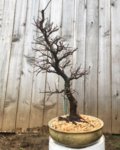Gurudas
Mame
I’m working on a longer term informal upright Chinese elm. I purchased the tree in early 2012 and its first three years were subpar due to my noob usage (“learning opportunity”) of subpar soil material (too organic), inadequate pot sizing, and poor timing of pruning.
Tiny tree, mid-2012
View attachment 133856
Repotted in 2014; here it is in April:
View attachment 133852
Repotted again in 2015; here’s March:
View attachment 133855
June 2015; I let it grow without restriction and fed heavily:
View attachment 133854
January 2016:
View attachment 133853
Updates coming…
Hello parhamr, I was hoping to ask about the optimal time to prune Chinese Elms. At what stage of the growing season would it be considered best to prune a young elm when trunk development is the top priority still? I would like to start on the right track. Thank you!







